Transgenic Anopheles gambiae Giles (Diptera: Culicidae) mosquitoes have been developed that confer sexual sterility on males that carry a transgene encoding a protein which cuts ribosomal DNA. A relevant risk concern with transgenic mosquitoes is that their capacity to transmit known pathogens could be greater than the unmodified form. In this study, the ability to develop two human pathogens in these transgenic mosquitoes carrying a homing endonuclease which is expressed in the testes was compared with its nontransgenic siblings. Infections were performed with Plasmodium falciparum (Welch) and o'nyong-nyong virus (ONNV) and the results between the transgenic and nontransgenic sibling females were compared. There was no difference observed with ONNV isolate SG650 in intrathoracic infections or the 50% oral infectious dose measured at 14 d postinfection or in mean body titers. Some significant differences were observed for leg titers at the medium and highest doses for those individuals in which virus titer could be detected. No consistent difference was observed between the transgenic and nontransgenic comparator females in their ability to develop P. falciparum NF54 strain parasites. This particular transgene caused no significant effect in the ability of mosquitoes to become infected by these two pathogens in this genetic background. These results are discussed in the context of risk to human health if these transgenic individuals were present in the environment.
How to translate text using browser tools
29 March 2019
Plasmodium falciparum (Haemosporodia: Plasmodiidae) and O'nyong-nyong Virus Development in a Transgenic Anopheles gambiae (Diptera: Culicidae) Strain
John D. Mumford,
Carole A. Long,
Scott C. Weaver,
Katzutoyo Miura,
Eryu Wang,
Rachel Rotenberry,
Ellen M. Dotson,
Mark Q. Benedict

Journal of Medical Entomology
Vol. 56 • No. 4
July 2019
Vol. 56 • No. 4
July 2019
arbovirus
competence
malaria
risk
transgenic




